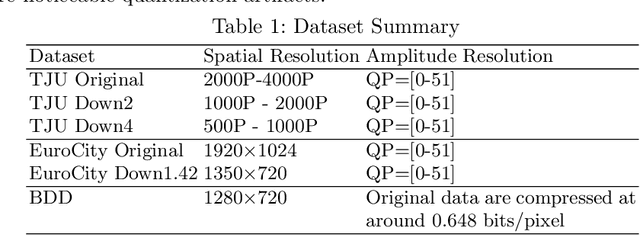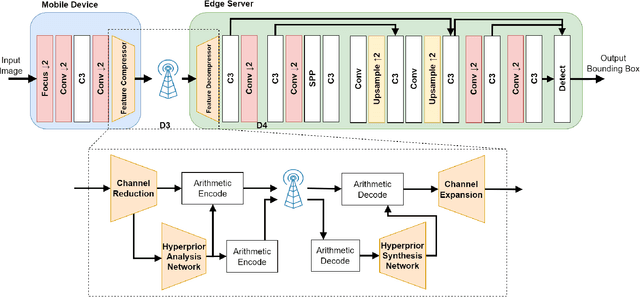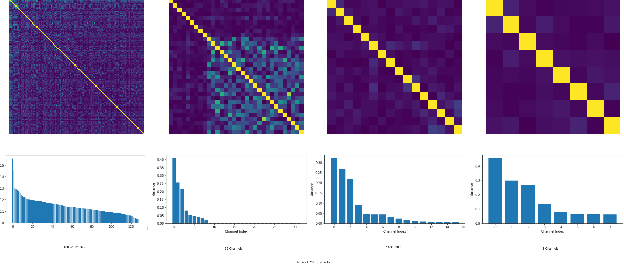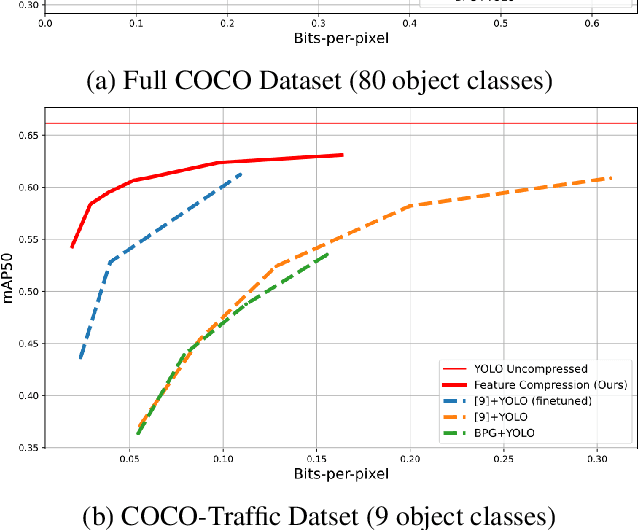Zhongzheng Yuan
Understanding the Impact of Image Quality and Distance of Objects to Object Detection Performance
Sep 17, 2022



Abstract:Deep learning has made great strides for object detection in images. The detection accuracy and computational cost of object detection depend on the spatial resolution of an image, which may be constrained by both the camera and storage considerations. Compression is often achieved by reducing either spatial or amplitude resolution or, at times, both, both of which have well-known effects on performance. Detection accuracy also depends on the distance of the object of interest from the camera. Our work examines the impact of spatial and amplitude resolution, as well as object distance, on object detection accuracy and computational cost. We develop a resolution-adaptive variant of YOLOv5 (RA-YOLO), which varies the number of scales in the feature pyramid and detection head based on the spatial resolution of the input image. To train and evaluate this new method, we created a dataset of images with diverse spatial and amplitude resolutions by combining images from the TJU and Eurocity datasets and generating different resolutions by applying spatial resizing and compression. We first show that RA-YOLO achieves a good trade-off between detection accuracy and inference time over a large range of spatial resolutions. We then evaluate the impact of spatial and amplitude resolutions on object detection accuracy using the proposed RA-YOLO model. We demonstrate that the optimal spatial resolution that leads to the highest detection accuracy depends on the 'tolerated' image size. We further assess the impact of the distance of an object to the camera on the detection accuracy and show that higher spatial resolution enables a greater detection range. These results provide important guidelines for choosing the image spatial resolution and compression settings predicated on available bandwidth, storage, desired inference time, and/or desired detection range, in practical applications.
Feature Compression for Rate Constrained Object Detection on the Edge
Apr 15, 2022



Abstract:Recent advances in computer vision has led to a growth of interest in deploying visual analytics model on mobile devices. However, most mobile devices have limited computing power, which prohibits them from running large scale visual analytics neural networks. An emerging approach to solve this problem is to offload the computation of these neural networks to computing resources at an edge server. Efficient computation offloading requires optimizing the trade-off between multiple objectives including compressed data rate, analytics performance, and computation speed. In this work, we consider a "split computation" system to offload a part of the computation of the YOLO object detection model. We propose a learnable feature compression approach to compress the intermediate YOLO features with light-weight computation. We train the feature compression and decompression module together with the YOLO model to optimize the object detection accuracy under a rate constraint. Compared to baseline methods that apply either standard image compression or learned image compression at the mobile and perform image decompression and YOLO at the edge, the proposed system achieves higher detection accuracy at the low to medium rate range. Furthermore, the proposed system requires substantially lower computation time on the mobile device with CPU only.
Network-Aware 5G Edge Computing for Object Detection: Augmenting Wearables to "See'' More, Farther and Faster
Dec 25, 2021



Abstract:Advanced wearable devices are increasingly incorporating high-resolution multi-camera systems. As state-of-the-art neural networks for processing the resulting image data are computationally demanding, there has been growing interest in leveraging fifth generation (5G) wireless connectivity and mobile edge computing for offloading this processing to the cloud. To assess this possibility, this paper presents a detailed simulation and evaluation of 5G wireless offloading for object detection within a powerful, new smart wearable called VIS4ION, for the Blind-and-Visually Impaired (BVI). The current VIS4ION system is an instrumented book-bag with high-resolution cameras, vision processing and haptic and audio feedback. The paper considers uploading the camera data to a mobile edge cloud to perform real-time object detection and transmitting the detection results back to the wearable. To determine the video requirements, the paper evaluates the impact of video bit rate and resolution on object detection accuracy and range. A new street scene dataset with labeled objects relevant to BVI navigation is leveraged for analysis. The vision evaluation is combined with a detailed full-stack wireless network simulation to determine the distribution of throughputs and delays with real navigation paths and ray-tracing from new high-resolution 3D models in an urban environment. For comparison, the wireless simulation considers both a standard 4G-Long Term Evolution (LTE) carrier and high-rate 5G millimeter-wave (mmWave) carrier. The work thus provides a thorough and realistic assessment of edge computing with mmWave connectivity in an application with both high bandwidth and low latency requirements.
 Add to Chrome
Add to Chrome Add to Firefox
Add to Firefox Add to Edge
Add to Edge